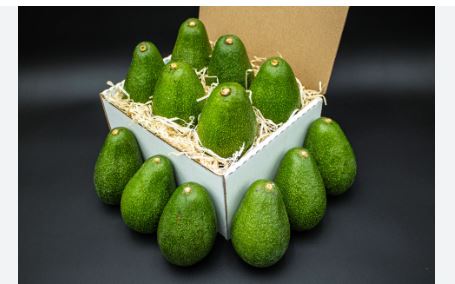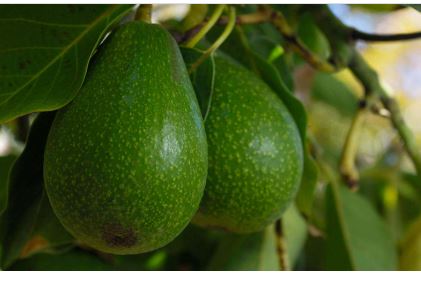
Fuerte avocados belong to the species Persea americana within the Lauraceae family, a botanical group that includes aromatic plants like cinnamon and bay laurel. Classified as a berry due to its single-seeded, fleshy fruit, Fuerte is a hybrid cultivar with a mix of Mexican and Guatemalan ancestry. The Mexican lineage (about 60-70%) lends it cold tolerance and a thinner skin, while the Guatemalan influence (30-40%) contributes to its larger size and richer flavor. This hybrid vigor helped it become a commercial standout in the early 20th century before Hass eclipsed it.
The origin of the Fuerte avocado traces back to Puebla, Mexico, where it was discovered around 1911 by horticulturist Carl Schmidt. Working for the West India Gardens nursery in Altadena, California, Schmidt collected cuttings from an exceptional tree owned by a farmer named Alejandro Le Blanc. Named “Fuerte” (Spanish for “strong”) for surviving a harsh 1913 freeze that killed many other varieties, it was introduced to California growers and quickly rose to prominence. By the 1920s, it was the leading U.S. avocado, prized for its quality and resilience, until Hass overtook it in the 1970s.
Identifying a Fuerte avocado is easy once you know its traits. It’s pear-shaped with smooth, thin, bright green skin that remains green even when ripe—a contrast to Hass’s darkening peel. The fruit typically weighs 8 to 14 ounces (225-400 grams), with pale green flesh that’s creamy but less oily than Hass (oil content around 12-16%). Its texture is smooth and slightly fibrous, with a large, teardrop-shaped seed that takes up noticeable space. The skin peels away easily, revealing a subtle sheen on the flesh.
Fuerte avocados grow best in USDA Hardiness Zones 9 to 11, thriving in mild, subtropical climates with minimal frost risk. They tolerate temperatures down to about 26°F (-3°C) better than pure Guatemalan varieties, thanks to their Mexican genes, but prolonged cold damages blossoms and young fruit. California’s coastal regions, like Ventura and Santa Barbara Counties, are prime growing areas, as are parts of Florida and Mexico. Well-drained, loamy soils and full sun exposure are non-negotiable for healthy trees, which can reach 30-40 feet if unpruned.

Seasonality for Fuerte runs from late fall to early spring, typically November to April in California, making it a winter standout when Hass production dips. Unlike Hass, which can hang on trees for months, Fuerte’s thinner skin limits on-tree storage, so it’s harvested mature but firm and ripened off-tree. Availability has waned as Hass dominates year-round supply via imports, but Fuerte remains a niche favorite in local markets or specialty stores, especially in regions where it’s still grown. Its peak quality aligns with cooler months, offering a seasonal contrast.
Culinary uses of Fuerte avocados lean on its milder, grassier flavor and less dense texture. It’s less ideal for heavy guacamole—its lower oil content can make it watery when mashed—but shines in fresh applications. Sliced into salads with citrus or tomatoes, it adds a delicate creaminess without overpowering other ingredients. Spread on toast or blended into dressings, its subtle taste pairs well with herbs or spices. In Florida, where high-water-content avocados are common, it’s often scooped straight from the skin with a drizzle of lime. Its lighter profile makes it a refreshing alternative to richer varieties like Hass.
Cultivation of Fuerte Avocados
Climate Requirements
Fuerte avocados thrive in subtropical climates within USDA Hardiness Zones 9 to 11, preferring mild temperatures between 60°F and 80°F (15°C to 27°C). Their Mexican ancestry gives them better cold tolerance than pure Guatemalan varieties, surviving brief drops to 26°F (-3°C), though frost damages blossoms and young fruit. Growers in coastal California or similar frost-free zones often use wind machines or sprinklers during rare cold snaps to protect crops.
Soil Preferences
Well-drained soil is critical, as Fuerte is susceptible to root rot (Phytophthora cinnamomi). Sandy loam or loam soils with a pH of 6.0 to 6.5 are ideal, allowing water to percolate quickly. Heavy clay requires amendment with organic matter or raised beds to prevent waterlogging. Soil testing before planting ensures proper drainage and nutrient levels, as Fuerte’s shallow roots demand aeration.
Site Selection
Gently sloping sites (5-10% grade) are preferred to shed excess water, though flat land works with careful irrigation. Full sun—6-8 hours daily—is non-negotiable for fruit set and growth. Wind protection is key, as Fuerte’s thin-skinned fruit and blossoms are vulnerable to damage; natural barriers like hills or planted windbreaks (e.g., eucalyptus) shield orchards effectively.
Tree Propagation
Fuerte is propagated via grafting onto hardy rootstocks like ‘Topa Topa’ or ‘Mexicola’ to ensure disease resistance and consistent fruit traits. Seeds from Fuerte fruit won’t breed true due to its hybrid nature, so nursery-grown grafts (scions from certified trees) are standard. Young trees are nurtured for 12-18 months before transplanting, establishing a strong root system.
Planting
Trees are spaced 15-20 feet (4.5-6 meters) apart to accommodate their broad canopies, though denser planting (12-15 feet) is possible with pruning. Spring planting, after the last frost, is optimal in regions like California, giving roots time to settle before summer heat. Holes twice the root ball’s size are filled with compost-amended soil, and stakes support trees against wind for the first year.
Irrigation
Fuerte requires consistent but moderate watering—20-40 gallons (75-150 liters) per tree weekly, depending on age and rainfall. Drip irrigation targets the root zone, avoiding trunk saturation that invites rot. Young trees need watering 2-3 times weekly, while mature ones adapt to less frequent cycles. Soil moisture is monitored to prevent overwatering, a common pitfall with this variety.
Fertilization
Nitrogen drives Fuerte’s growth, applied at 1-1.5 pounds (0.45-0.7 kg) per tree yearly, split between early spring and late summer. Zinc and boron supplements correct deficiencies common in alkaline soils, often delivered via foliar sprays. Compost or balanced fertilizers (e.g., 8-3-9 NPK) support vigor, but over-fertilizing risks leaf burn or reduced fruit quality, so annual leaf analysis guides adjustments.
Pollination
Fuerte is a Type B flowerer—female in the afternoon, male the next morning—making it partially self-fertile but more productive with cross-pollination. Planting Type A varieties like Hass or ‘Pinkerton’ nearby enhances yield, as bees transfer pollen during overlapping bloom periods (late winter to spring in California). Growers often add hives to orchards to boost pollination success.
Pruning
Light pruning shapes Fuerte trees, removing dead wood, suckers, or crowded branches to improve air circulation and light penetration. Young trees are trained into an open, vase-like form over 2-3 years, while mature trees need only occasional thinning post-harvest (spring) to avoid stress. Heavy cuts are rare, as Fuerte’s vigorous growth naturally balances fruit load.
Pest and Disease Management
Avocado thrips and persea mites are primary pests, managed with predatory insects (e.g., ladybugs) or targeted sprays like neem oil. Root rot is the biggest disease threat, countered with resistant rootstocks and strict water control. Regular scouting and sanitation—removing fallen fruit—limit infestations, keeping chemical use minimal in sustainable orchards.
Fruit Development
After pollination, Fuerte fruit matures over 7-9 months, reaching harvest readiness from November to April in California. Unlike Hass, it can’t hang long on-tree due to thin skin, so timing aligns with dry matter testing (18-22% minimum). Fruit grows to 8-14 ounces (225-400 grams), with size influenced by water, thinning, and tree health.
Harvesting
Fuerte is picked mature but unripe, when firm and green, using clippers to snip stems cleanly. Workers target fruit at peak oil content, tested via samples, with harvest spanning late fall to spring. Ladders or poles reach higher branches, and fruit is collected in padded bins to prevent bruising its delicate skin—an advantage over tougher-skinned Hass.
Post-Harvest Care
Harvested Fuerte avocados are cooled to 40-45°F (4-7°C) to slow ripening, then graded for size and blemishes. Ripening occurs off-tree at room temperature (65-75°F/18-24°C) over 7-14 days, or faster with ethylene in commercial settings. Thin skin limits shelf life compared to Hass, so timely distribution is key. Trees can produce 80-150 pounds (36-68 kg) annually for decades with proper care.